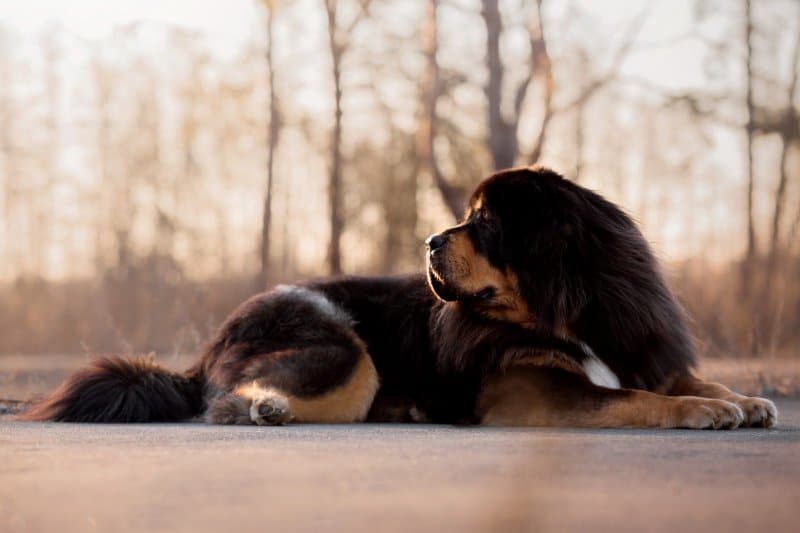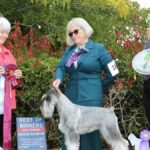Lovable Not Huggable: Some Breeds Are Allowed to Be ‘Reserved With Strangers’
It’s open season on dogs. Maybe you’ve noticed how every dog today is expected to tolerate unwanted affection from complete strangers. Whether in the park or on the street, the appearance of a dog seems to provoke an uncontrollable urge in some passersby to touch — nay, hug — the dog without first asking permission from the dog’s walker. It seems as if a dog can’t simply “do its business” anymore without being cossetted by self-proclaimed “dog lovers” with little to no impulse control. When did every dog that appears in public become public property?
Although dogs certainly do bring emotional benefits to people’s lives, it is not the responsibility of every dog to make every person they encounter happy. In fact, when it comes to purebred dogs, encounters with strangers are breed-specific. They are predictable and clearly defined by each breed’s written standard. For example, the Golden Retriever standard requires dogs of this breed to be “friendly, reliable and trustworthy.” This is—quite literally—the gold standard for a breed that welcomes attention from everyone they meet. Unfortunately, it has also become the standard by which every dog is expected to behave in public. This is true even for those breeds that are allowed to be “reserved with strangers.”
The standards that define a breed, in part, as behaving in an “aloof” or “reserved” manner when meeting a stranger (a person with whom one has had no personal acquaintance) include breeds from each American Kennel Club Group. As might be expected, breeds from the Working and Herding Groups are well represented. After all, many of these breeds were developed as guardians of person and property, or places where visitors were viewed with suspicion. More surprisingly, perhaps, are the number of Sporting and Non-Sporting breeds that are permitted to consider strangers with reservation.
Their outgoing personalities notwithstanding, many breeds in these Groups have a history of working alongside their favorite person in occupations that didn’t require them to be gregarious. Similarly, many of the Hound breeds developed quite independently and got along just fine without benefit of an entourage of adoring fans. Even the Terrier and Toy breeds, those genuine extroverts of the dog world, have a few members that are permitted to be a bit reticent from time to time.
Among the breeds of the Sporting Group, eight standards describe temperament in some way that is either aloof or reserved with strangers. The Nederlandse Kooikerhondje “… can be a bit reserved with strangers” and the German Wirehaired Pointer is “… at times aloof but not unfriendly toward strangers.” The Curly-Coated Retriever “… sometimes appears aloof or self-willed, and, as such, is often less demonstrative, particularly toward strangers, than the other retriever breeds.”
The Nova Scotia Duck Tolling Retriever may behave similarly. “Some individuals may display reserved behavior in new situations, but this not to be confused with shyness.” As for the Field Spaniel, “They may be somewhat reserved in initial meetings.” The Irish Water Spaniel’s temperament is a bit more enigmatic. “May be reserved with strangers but never aggressive or shy,” notes the current standard. The Welsh Springer Spaniel is a bit more restrained. Its standard reads, “Although reserved with strangers, he is not timid, shy nor unfriendly.” And the Wirehaired Vizsla is “… occasionally aloof with strangers and has a keen protective instinct.”
Not every breed standard mentions temperament or disposition. Most of the Hound breeds are defined by standards that fail to mention temperament at all. The Afghan Hound is one of six that does, although its description is as brief as it is ambiguous: “Aloof and dignified, yet gay.” The recently recognized Azawakh is “… reserved with strangers, but he can be gentle and affectionate with those he is willing to accept.” (This breed makes friends strictly on its own terms!) “Can be aloof with strangers,” reads the Basenji standard.
The only scenthound with reservations about introductions is the Black and Tan Coonhound. “Some may be reserved but never shy or vicious,” according to its breed standard. The description of the Rhodesian Ridgeback’s temperament is as plainly put as the breed it describes: “Reserved with Strangers.” And another African Hound, the Sloughi, is simultaneously aristocratic and remote. “The attitude is noble and somewhat aloof,” according to its AKC breed standard.
Many of the breeds in the Working Group have standards that address extremes of viciousness and shyness. However, 14 standards stick with more generalized terms. The Anatolian Shepherd Dog is a good example. “Reserve around strangers and off its territory is acceptable,” notes the breed standard. The Bernese Mountain Dog “… may remain aloof to the attentions of strangers.” More forcefully, the Black Russian Terrier “…does not relish intrusion by strangers into its personal space.” (Knock, knock!) The Boerboel is confident, “… at times displaying a self-assured aloofness.” The Boxer is steadfast and tractable. “Deliberate and wary with strangers,” according to its standard. A recent addition to the Working Group, the Chinook is neither timid not antagonistic. According to the breed standard, “… some Chinooks may be reserved with strangers but should never appear shy or aggressive.”
The German Pinscher is “…deliberate and watchful of strangers.” For the Great Pyrenees, character and temperament are of utmost importance. “He is strong-willed, independent and somewhat reserved…” and “may appear reserved in the show ring,” according to the AKC standard. The Komondor is both standoffish and a total sweetheart. “While reserved with strangers, the Komondor is demonstrative with those he loves,” the breed standard notes. “Polite to accepted strangers…” is how the Kuvasz is expected to behave.
The Neapolitan Mastiff “… is always watchful and does not relish intrusion by strangers into his personal space.” (Best to be an invited guest!) “An aloof or reserved dog should not be penalized…” in the show ring, reads the standard for the Rottweiler. “Some measure of reserve and dignity,” describes the Siberian Husky. “He does not display the possessive qualities of the guard dog, nor is he overly suspicious of strangers.” And the Tibetan Mastiff is a “…strong willed and rather reserved dog… He is aloof with strangers and highly protective of his charges and his property.” (Enter at your own risk!)
Not many Terrier breeds have a standard that mentions temperament. (Though many do describe an aggressiveness toward other dogs.) One notable exception is the Irish Terrier. Its breed standard is positively poetic in its description of temperament: “He is good tempered, spirited and game. It is of the utmost importance that the Irish Terrier show fire and animation. There is a heedless, reckless pluck about the Irish Terrier which is characteristic, and which, coupled with the headlong dash, blind to all consequences, with which he rushes at his adversary, has earned for the breed the proud epithet of ‘Daredevil.’ He is of good temper, most affectionate, and absolutely loyal to mankind. Tender and forbearing with those he loves, this rugged, stout-hearted Terrier will guard his master, mistress and children with utter contempt for danger or hurt. His life is one continuous and eager offering of loyal and faithful companionship and devotion. He is ever on guard, and stands between his home and all that threatens. (James Joyce couldn’t have written a finer description of any breed’s character.) The few Terrier breeds that describe a “reserved” temperament include the Cesky Terrier that is “somewhat reserved towards strangers.” “Independent, determined, reserved and intelligent,” defines the Dandie Dinmont Terrier. America’s Rat Terrier “…may be reserved with strangers.” Likewise, Scotland’s Skye Terrier is “…reserved and cautious with strangers.”
Collectively, the breeds of the Toy Group are the least likely to be reserved with strangers. Heck, they’re the least likely to be reserved, period! These little dogs are the true extroverts of the dog world. Any why wouldn’t they be? Each of these diminutive breeds was developed solely to be pampered and petted. (Even the Terrier-like Chihuahua likes to be held—when it wants to.) From the Imperial Palace to the Royal Houses of Europe, Toy dogs have always welcomed a hug—primarily from societies’ upper classes.
However, democracy has allowed generations of Papillons, Pekingese and Pomeranians to becoming accustomed to handling by all and sundry, allowing dog lovers from every walk of life to express their fondness for fondling a miniature Spaniel or Spitz. What was once an exclusive privilege has now become an expectation among the masses. But for the introverted Toy dog admirer, one breed still exists with a discerning view of humanity. The Japanese Chin remains “…reserved with strangers or in new situations.”
Breeds that are aloof may be permitted to “read” its handler’s apprehension with strangers and respond accordingly. Among Non-Sporting breeds, the American Eskimo Dog is permitted to sound “a warning bark to announce the arrival of a stranger.” The Chinese Shar-Pei is “somewhat standoffish with strangers.” The Chow Chow possesses “an aura of aloofness” that seems to exist in the atmosphere that surrounds the breed. “It is a Chow’s nature to be reserved and discerning with strangers,” instructs the breed standard. “Gay and assertive, but chary with strangers,” is the Lhasa Apso’s birthright. Similarly, the high-climbing Norwegian Lundehunde “…can be wary of strangers.” Actually, the list of Non-Sporting breeds with reservations of temperament is truly international.
The Dutch Schipperke is “reserved with strangers.” Japan’s Shiba Inu “can be reserved with strangers.” The Tibetan Spaniel is “aloof with strangers” as is its larger cousin. “The breed may be cautious or reserved,” reads the standard for the Tibetan Terrier. Mexico’s Xoloitzcuintli rounds out the list. The standard for this breed’s Toy, Miniature and Standard varieties is the same as regards disposition: “Typical Xolo temperament is calm, tranquil, aloof and attentive.”
When it comes to the hard-working Herding breeds, the standards sometimes describe a temperament that is “suspicious” of strangers. For example, the Puli standard describes a dog that is “sensibly suspicious and therefore an excellent watchdog.” Likewise, the Australian Cattle Dog is defined as “…naturally suspicious of strangers.” The Australian Shepherd (no relation) possesses a similar disposition, but with one caveat. “He may be somewhat reserved in initial meetings,” notes the standard.
The Beauceron of France “… can be reserved with strangers.” Likewise, the Belgian Malinois “may be reserved with strangers,” and the Belgian Sheepdog and Tervuran standards read identically with regards to temperament. “In their relationship with humans, they should be observant and vigilant with strangers, but not apprehensive.” The always busy Border Collie “may be sensibly reserved with strangers.” Another French breed, the Briard, is a true romantic. “Although he is reserved with strangers, he is loving and loyal to those he knows,” according to the standard.
From Israel, the Canaan Dog can be aloof without the love. “Reserved and aloof with strangers,” describes this Middle Eastern breed. The Swiss Entlebucher Mountain Dog “may be reserved with strangers.” Finnish Lapphund can be similarly fickle. “At times, they may appear a little distant and aloof,” the breed standard notes. The heroic German Shepherd Dog possesses “a certain aloofness” according to its breed standard, whereas its neighbor, the Polish Lowland Sheepdog, is “somewhat aloof and suspicious of strangers.” The Pyrenean Shepherd is “distrustful of strangers.” The Shetland Sheepdog “may be reserved toward strangers.” And the Spanish Water Dog is “…naturally suspicious of strangers.”
So, the next time your dog is about to be accosted on the street—or you’re about to do the same thing to a stranger’s dog remember that each breed possesses its very own threshold for accepting an uninvited touch. A Golden will very likely welcome it, but the Tibetan Mastiff? Not so much. Oh, and don’t worry too much about those Goldendoodles. Designer dogs aren’t entirely sure how they’re supposed to respond to hugs from strangers.









